Soaked Brown Rice 2 Ways
Several years ago, long before I became this paranoid health-foodie of a mom, my husband worked retail in a pretty remote little town and he always came home with awesomely hilarious lunchbreak conversation stories. My two favorites were “Have you ever noticed that water ain’t got no flavor?” and “Did you know that eating a bowl of rice is like eating a bowl of sugar?”
We always had a good chuckle, but in the back of my mind that second one haunted me. I mean guys, I am Japanese. (Well, half, but let’s not get too technical here) I LOOOOOOOVE me some rice. And Japan has one of the top 10 highest life expectancies in the world, and one of the lowest obesity percentages in the developed world, and we love rice. So things didn’t add up in my head. I mean, we’re all told that whole grain is better than refined, but is it really ever explained? We throw around buzz words like “healthy” and “high fiber” and “slow carb” and we’re generally pretty satisfied. And frankly, I was happy eating my bowl of white-rice-sugar 3 times a day and didn’t want to find out the reasons behind why I shouldn’t be eating what I wanted to keep eating.
But I’m a mommy, and these little babies entrusted in my care deserve the best. So, I swallowed my cultural pride and did a little digging. And hoooooly moly, people are passionate about this subject. There are heated articles on both sides.
First, what you should know is that white rice is just brown rice with the bran and germ removed. What I gathered from all of this research is that white rice should be eaten sparingly. See, the removal of the bran and germ strips the grain of a lot of it’s natural nutrients and does in fact spike your blood sugar, similarly to sugar. No, it’s not like eating a bowl of sugar, but the glycemic index is high, so you want to watch out. The other issue I have with white rice is that it’s often “enriched” with nutrients to make up for what we took away, which means that they add artificial sources of these nutrients that have been stripped from the original state of the grain. But artificial solitary sources of these nutrients aren’t readily absorbed by your body because it’s not really supposed to be there. My motto is always to go as close to the source as possible. Pretty sure God knew what he was doing when he created these plants, better than we humans could ever try to recreate.
So is brown rice the answer to life’s problems? Unfortunately, no. Brown rice has it’s issues, too. [insert whiney-face emoji] First of all, the bran and germ contain oils that can go rancid pretty quickly, so make sure your source is fresh and store your grains in the freezer or buy small amounts and replenish often. Easy peasy. The second problem is the real kicker: phytic acid. I’ve mentioned phytic acid before, but not in explicit detail. And, frankly, I’m not a scientist or a nutritionist, so I’m not sure I could explain it well. But here is a basic explanation from a source that can:
“Phytic acid is the principal storage form of phosphorus in many plant tissues, especially the bran portion of grains and other seeds. It contains the mineral phosphorus tightly bound in a snowflake-like molecule. In humans and animals with one stomach, the phosphorus is not readily bioavailable. In addition to blocking phosphorus availability, the “arms” of the phytic acid molecule readily bind with other minerals, such as calcium, magnesium, iron and zinc, making them unavailable as well. In this form, the compound is referred to as phytate.
Phytic acid not only grabs on to or chelates important minerals, but also inhibits enzymes that we need to digest our food, including pepsin, needed for the breakdown of proteins in the stomach, and amylase, needed for the breakdown of starch into sugar. Trypsin, needed for protein digestion in the small intestine, is also inhibited by phytates.“
So basically, phytic acid is good for the plant, but bad for us because it not only makes all of those awesome nutrients in the whole food unavailable to us, it blocks our absorption to other nutrients. And we want those nutrients and enzymes, do we not? I sure do.
And as I mentioned before, there’s a way around the phytic acid, and it’s through soaking, sprouting, and/or fermenting. Today, we’re going to talk about 2 basic methods of soaking brown rice to maximize nutrition and minimize anti-nutrients.
So this is the difference between soaked and unsoaked brown rice. Am I totally weird for thinking it’s beautiful? The grains become plump, opaque, and this gorgeous creamy color. And since they’ve absorbed so much liquid, they cook faster. The biggest thing I’ve learned from my experience with cooking from scratch is that when it comes to hands-on time, it actually doesn’t take longer. There’s just more thinking ahead. And my favorite trick is to cook double and freeze half so that last-minute meals (because no matter how prepared you are, they happen) are a breeze to pull together.
The most effective way to remove phytic acid is to the ferment rice. I know, sounds scary, right? I was worried, too. I thought I’d accidentally grow some weird gray-ish green fuzz or have some sauerkraut-tasting rice. But when I found out that it reduces phytic acid by 96% (!!!), I decided I needed to at least give it a shot. And it was surprisingly easy and the result didn’t have any funky flavor to it. But for the sake of those of you who are hesitant or just don’t have the time to worry about it, I’m showing you another method. It might not be quite as effective (I mean, 96%!), but it still works.
The general rule is to use 1 cup grain, 1 cup water, to 2 tablespoons acid. The best acids to use are either fresh lemon/lime juice or raw apple cider vinegar. Side note: I recently read that calcium-rich acids (such as kefir, yogurt, whey, buttermilk, etc) may inhibit the breakdown of phytic acid and therefore are not effective for this application. So choose your acid wisely, my friends!
Let’s get started, shall we?
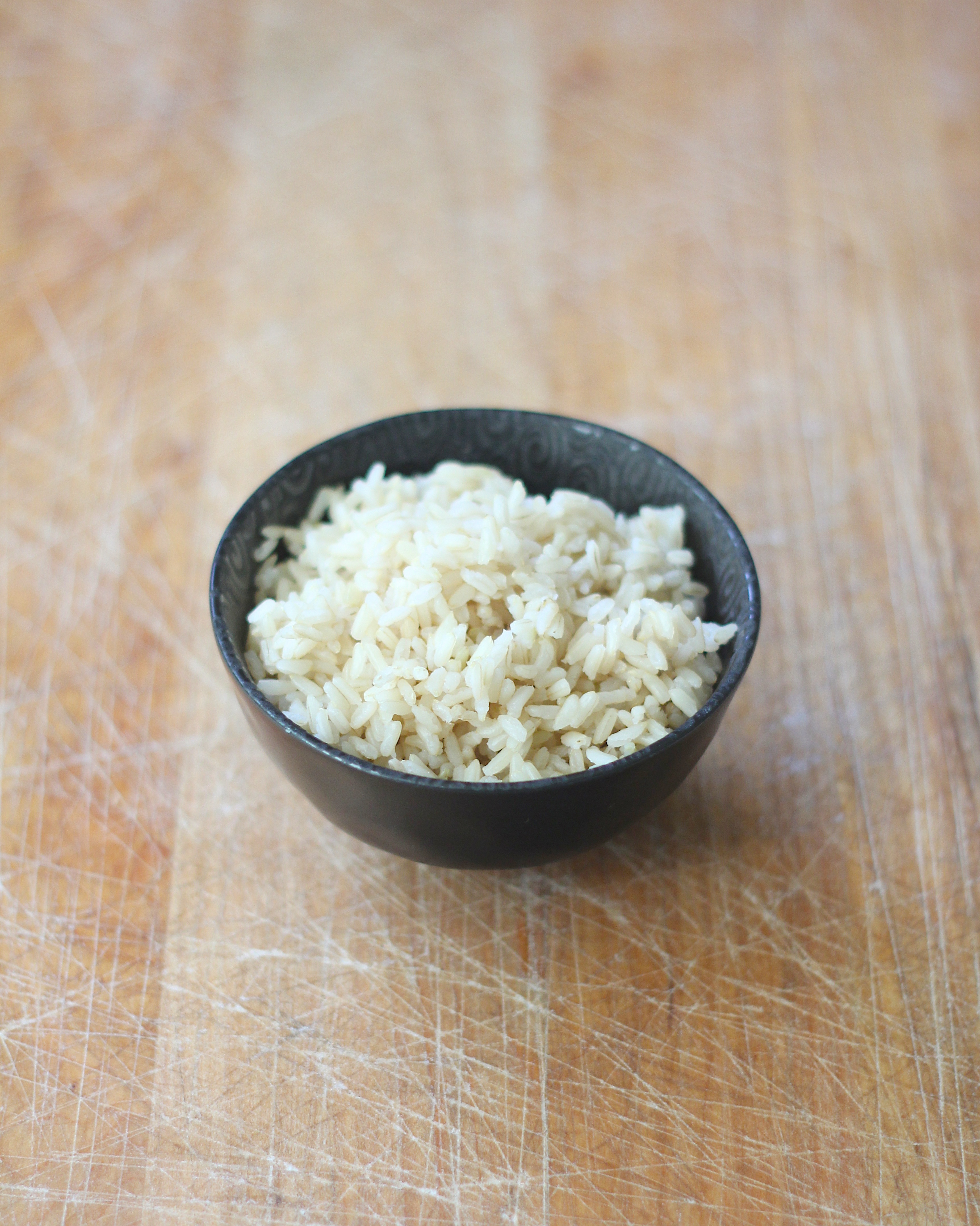

- 3.75 cups (5 rice cooker cups, if using a rice cooker) brown rice
- 4 cups very warm water, preferably purified and dechlorinated* (for soaking)
- 1/2 cup acidic medium (fresh lemon/lime juice or raw apple cider vinegar)
- 4 cups water, preferably purified and dechlorinated (for cooking)
- In a clean large glass or ceramic bowl, combine the rice, 4 cups warm water, and acid. Cover, and let sit overnight, 8-12 hours, and even up to 24 hours.
- Once soaking is done, wash thoroughly to prepare for cooking.
- After rinsing the soaked rice thoroughly, shake excess water off and use one of the following methods, either with a rice cooker or on the stove top.
- Add the rice to the bowl of the rice cooker and fill water to the 5 cup marking. It should amount to about 4 cups of water, which is significantly less than you would use to cook unsoaked grains due to the water absorbed during soaking. Turn on and cook according to regular brown rice setting on your rice cooker. (I've even used the regular white rice setting in my older model with no problems)
- In a large pot, combine soaked rice and water. Bring to a boil, then drop down to a simmer and cover with a tight fitting lid. Let cook with lid on until the water is absorbed and rice is fluffy, no longer opaque, and has a tender center, about 40 minutes.
- If using the stovetop method, it's a good idea to use a pot with a glass lid if you have one. Doneness is more about appearance than time, so it's nice to be able to keep an eye on it without letting the steam escape.
- *to dechlorinate and purify water, simply boil for 20 minutes and let cool to room temperature.
The challenge is that you need a 24-hour soak/ferment. And thinking that far in advance is annoying. But you can’t change lifestyle without changing habits, right? It may take some getting used to, but you’ll get the hang of it. For example, if you want rice for dinner on Tuesday, for a stay at home mom like myself:
- Monday, 3:00 pm: start your rice to soak.
- Tuesday, 3:00 pm: Wash, put in rice cooker with clean water, and turn on rice cooker.
- Tuesday, 3:30~3:45 pm: rice is done cooking, and left on warmer setting, waiting for you.
But for someone who works outside of the home and you have a rice cooker, your schedule could look like:
- Monday, 7:00 am: start your rice to soak.
- Tuesday, 7:00 am: Wash, put in rice cooker with clean water, and turn on rice cooker.
- Tuesday, 7:30~7:45 am: rice is done cooking, and left on warmer setting, waiting for you.
Or for someone that works outside of the home and doesn’t have a rice cooker:
- Monday, 5:30 pm: start your rice to soak.
- Tuesday, 5:30 pm: Wash, put in pot with clean water, bring to a boil, drop to a simmer.
- Tuesday, 6:00~6:15 pm: rice is done cooking, right around the time when you’re done with whatever else you are serving with the rice.
You get the idea. Hands on time is actually minimal, it just takes a lot of planning. When I plan my weekly menu, I set alarms on my phone to remind myself to start my rice, bread, whatever else I have planned so I’m not scrambling for last minute lunches and dinners. And when I do scramble, I’m grateful I cooked a double batch and have some in the freezer. And when I don’t have that, I’m grateful for Chipotle;)
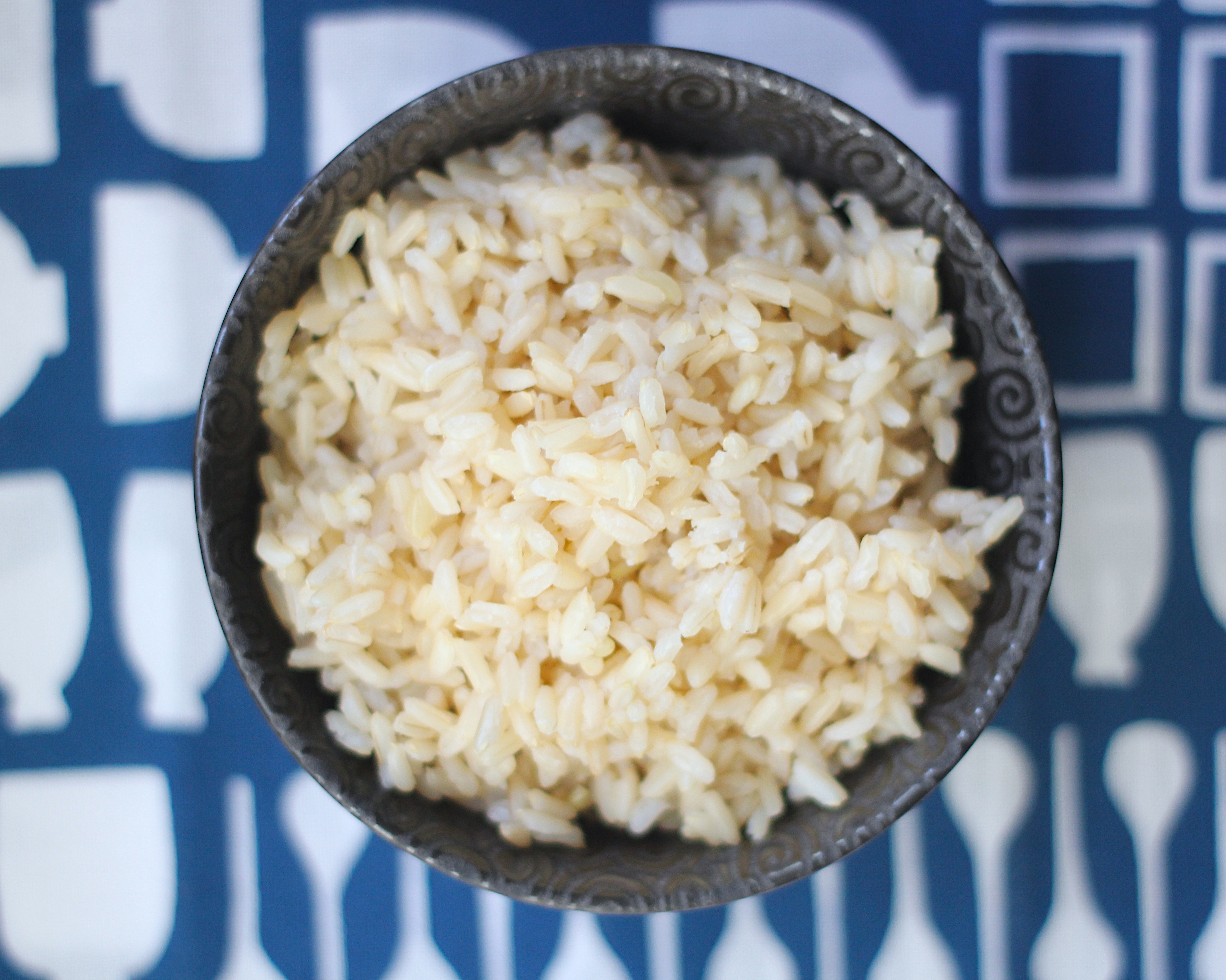

- 3.75 cups (5 rice cooker cups, if using a rice cooker)
- 4 cups purified and dechlorinated water, room temperature (for soaking/fermenting)
- 4 cups water, preferably purified, for cooking
- Soak the rice in water for 24 hours at room temperature.
- Once the soaking period is complete, reserve between 1/3 and 1/2 cup (about 10%) of the soaking liquid and add it the next time you soak. (This will last in the fridge for a long time)
- Once soaking is done, wash thoroughly to prepare for cooking.
- Cooking
- After rinsing the soaked rice thoroughly, shake excess water off and use one of the following methods, either with a rice cooker or on the stove top.
- Rice cooker method
- Add the rice to the bowl of the rice cooker and fill water to the 5 cup marking. It should amount to about 4 cups of water, which is significantly less than you would use to cook unsoaked grains due to the water absorbed during soaking. Turn on and cook according to regular brown rice setting on your rice cooker. (I've even used the regular white rice setting in my older model with no problems)
- Stovetop method
- In a large pot, combine soaked rice and water. Bring to a boil, then drop down to a simmer and cover with a tight fitting lid. Let cook with lid on until the water is absorbed and rice is fluffy, no longer opaque, and has a tender center, about 40 minutes.
- After 3 rounds of reserving the water, your rice will have removed 96% of the phytic acid or more.
- If using the stovetop method, it's a good idea to use a pot with a glass lid if you have one. Doneness is more about appearance than time, so it's nice to be able to keep an eye on it without letting the steam escape.
- *to dechlorinate and purify water, simply boil for 20 minutes and let cool to room temperature.
Comments
- Cooking beans 101 - Scratch Eats - […] at once. But the real problem is, yup you guessed it, phytic acid. (If you don;t know what that…
- Bean, Green and Coconut Milk Soup - Scratch Eats - […] I used soaked, cooked quinoa (using this method for rice). With this more Thai-inspired soup, rice noodles would work…
- Brown Rice Rolled Sushi 巻き寿司 - Scratch Eats - […] There are so many fillings you can use, but my go-to’s are always cucumbers, avocado, spicy sprouts (such as…
- Homemade Brown Rice Mochi 玄米もち - Scratch Eats - […] know what I’m talking about or how to do it, I go into detail about how to prepare your…
- Brown Rice Moffles (Mochi Waffles) 玄米モッフル - Scratch Eats - […] flavor. Plus, because this mochi is soaked ahead of time, you don’t have to worry about the thumbs-down part…
- Brown Rice Moffle Variations - Scratch Eats - […] (mochi waffles) are a crispy and chewy treat made with soaked brown rice for maximum nutrition absorption. And these…
- Veggie-Packed Pad Thai - Scratch Eats - […] a permanent place in my pantry. I don’t use brown rice noodles because I doubt they’ve eliminated phytic acid…
- Malaysian Claypot Chicken Rice (without the claypot ... or the chicken) - Scratch Eats - […] always, I suggest soaking the rice overnight or up to 24 hours prior to cooking to remove phytic acid…
- Black Beans and Soaked Brown Rice - Scratch Eats - […] and rice cooker and leave. (If you don’t have a rice cooker or slow cooker, look here and here…
- Homemade Gyoza - Scratch Eats - […] my husband doesn’t like any vinegar (which is totally not ok, IMO;)). Served alongside some soaked brown rice, you’ve…
- Classic Whole Wheat Sourdough Waffles - Scratch Eats - […] it pretty extensively before here on my blog, when I showed you how to deal with it when cooking…
- Salmon and Broccoli Rice Bowls with Citrus-Shoyu Glaze - Scratch Eats - […] to use Japanese short grain rice, it’s my favorite. And if you’re using brown rice, soak it ahead of…
- 30-minute Bi Bim Bop - Scratch Eats - […] white rice simply because of the time constraints, but if you have the time to think ahead, try my…
- 30 minute Coconut Chicken & Rice - Scratch Eats - […] it, and it’s delicious! It just won’t be a 30 minute meal any more. And remember to soak it…
- Sprouted Red Fife & Yogurt Crust Japanese Sweet Potato Pie - Scratch Eats - […] haven’t been soaked, sprouted, or soured. If you want to know more about that, you can see my previous…
- Meatless Okinawa Taco Rice - Scratch Eats - […] *to learn how to cook beans properly, look here. For brown rice, go here. […]
- Asian Chicken Salad with Zippy Sesame Dressing - Scratch Eats - […] about fermentation, right? Wait, you don’t? Short answer, you need it. Long answer, look here and here.The problem is not…
- Homemade Ricotta - Scratch Eats - […] You could also use this whey to soak grains, seeds, and nuts in to remove harmful anti-nutrients to make…

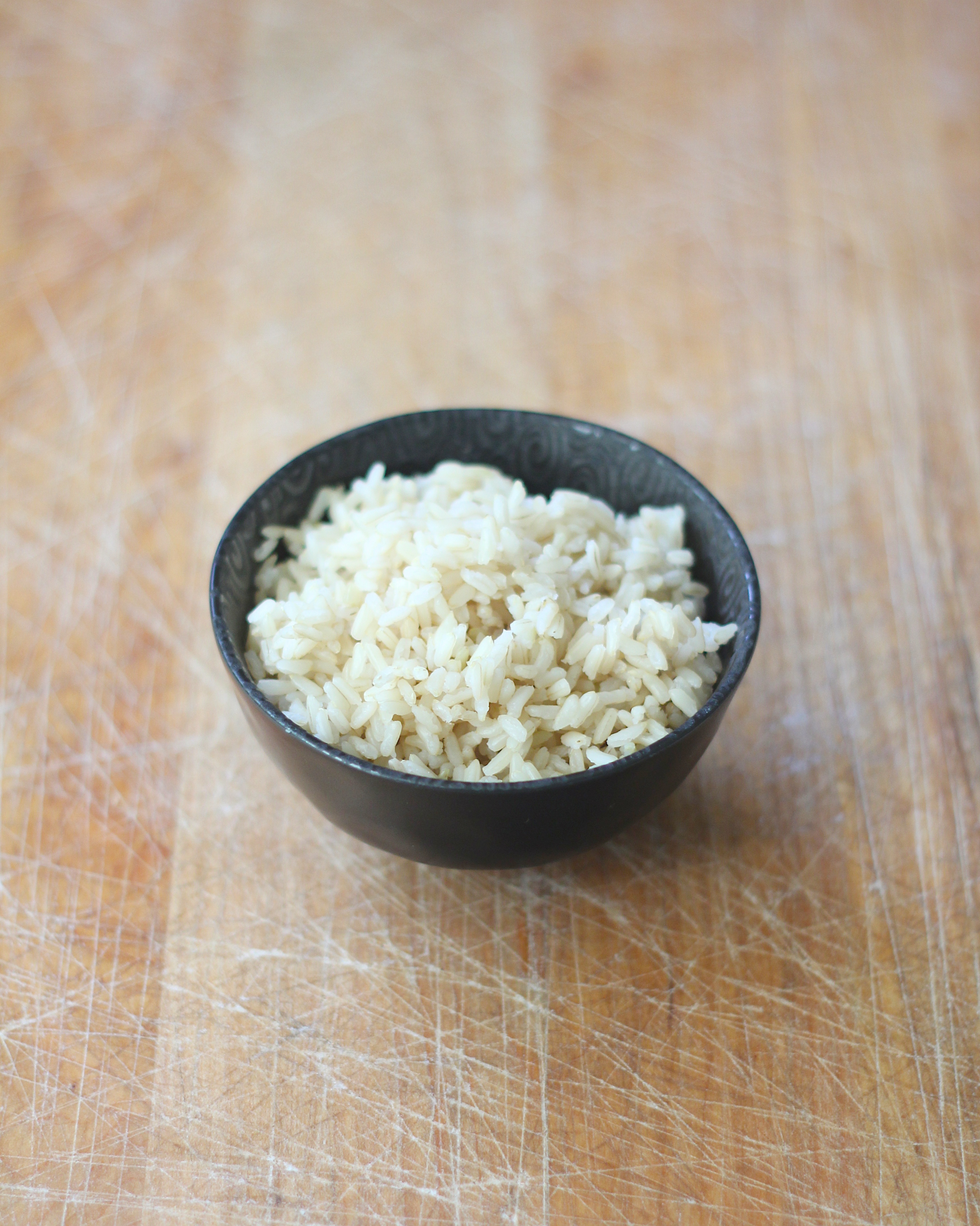
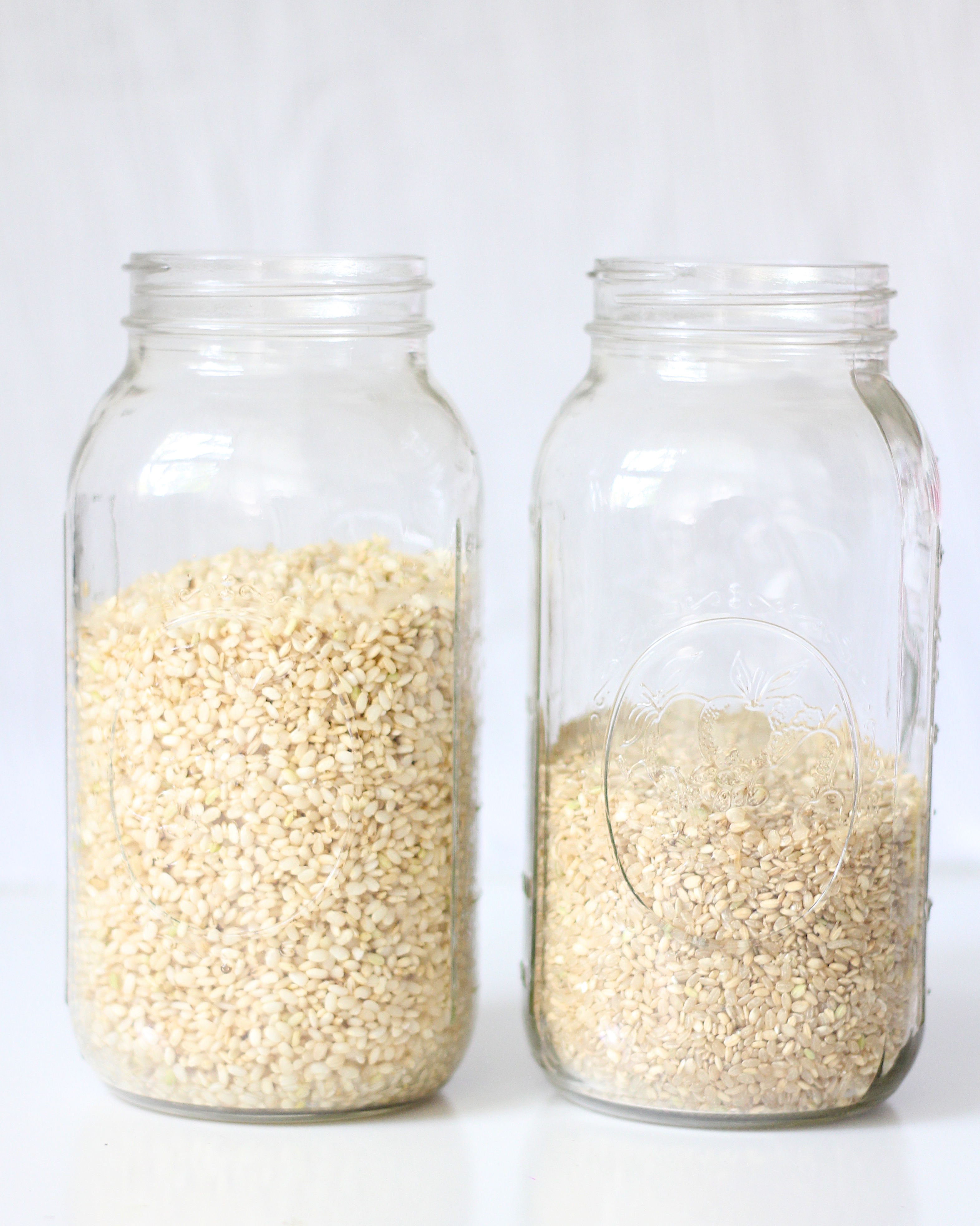

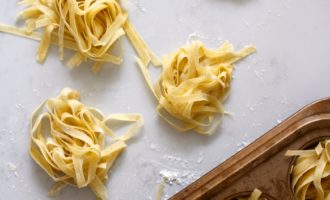
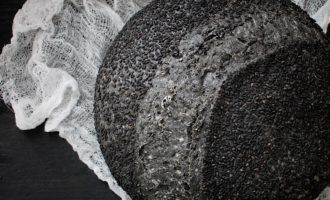
Celeste
September 30, 2015
Thanks for majorly doing your homework so people like me can easily educate ourselves about these staples! Prepare to be soaked, rice. P.S. I buy my brown rice in bulk at a nearby Asian market. Thought you’d be proud ;p
Lillian
October 2, 2015
Celeste, I am super proud!
Arif
February 29, 2016
First of all, love the site, way to go! Second, do you have a recipe for soeakd or sprouted whole wheat bread, especially one that makes lighter, or not super dense?
Lillian
March 2, 2016
Arif, I don’t currently have a recipe for soaked or sprouted whole wheat bread on my blog, but I do have a couple of sourdough whole wheat bread recipes. If that suits your needs, check my recipe index under “bread” and you’ll find some options. I hope that helps. Thanks for stopping by.
Risten
January 5, 2017
I realize I’m late, so here goes a long shot – we never actually soak the rice for more than 24 hours? And once we reuse the soak water for the 3rd time, do we just keep going? If there’s a 5 day break of rice, can we store it in the fridge? Thanks for the site, your pictures in particular are really well taken!
Lillian
January 15, 2017
Hi Risten! Yes, you soak the rice for a max of 24 hours. And you can definitely keep using the soaking liquid after the third use. I just wanted to explain that the break down of anti-nutrients was greater with each fermentation. After the third use and on is when it works best. Thanks for visiting!
Li,
July 14, 2019
Hi, can i use distilled water in replacing the purified water. Thanks a lot for sharing the post.